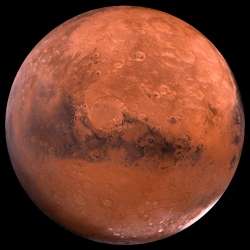
Planetary scientists dream of sending a geologist to Mars to study its rocks by hand. Until then, they have to settle for examining meteorites — chunks of the Red Planet that land on Earth after hurtling through space and surviving the searing fall through our atmosphere.
Though a little banged up, these meteorites provide a vital up-close view of our rust-hued neighbor. But it can be hard for geologists to interpret what they see when they can’t agree how old a rock is. Conflicting age estimates for certain rocks differ by up to 4 billion years — the vast majority of Mars’ planetary existence.
Do these rocks tell the beginning, or the end, of Mars’ story?
In a paper last month in the journal Nature, an international team of scientists sought to sort out this issue for a particular group of meteorites known as shergottites. Martian space rocks tend to be very old, but shergottites are generally thought to be remarkably young — forming as a result of volcanic activity about 150 million to 250 million years ago, around the same time that dinosaurs roamed during Earth’s Jurassic period.
If so, shergottites are a sign that Mars might have been geologically active fairly recently, and thus perhaps still amenable to some form of life, said Munir Humayun, a planetary geochemist at Florida State University who was not involved in the study.
But a few researchers recently estimated that shergottites are about 4 billion years old — a finding that had far-reaching implications for scientists’ understanding of Mars’ history.
"Most of us understand that if there is to be life on Mars it’s not going to be roaming on the surface, but it could be thriving underground with the heat energy provided by volcanism," Humayun said. But "if there hasn’t been [volcanic activity in] 4 billion years … it would be very difficult to believe there was life left on Mars."
